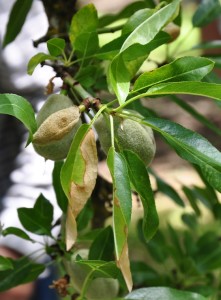Rain is forecasted for the coming Wednesday. Although the amounts appear to vary, the rain will be accompanied with warmer temperatures (>60F), which will favor the development of many fungal diseases. Diseases of concern with warmer rains include brown rot, shot hole, and anthracnose.

Depending upon stage of bloom/petal fall, the threat of brown rot may be reduced. My best guess is that the late blooming varieties of Butte/Padre/Mission still have some level of susceptible, but any fungicide application made during bloom should provide protection through this rainy period. The threat of brown rot on the earlier blooming varieties is much less. Shot hole is a consistent threat, and depending upon orchard history, a treatment may be warranted with the upcoming rain. The best timing for shot hole applications extend from petal fall through the spring, and should be based on presence of the pathogen and weather events.
Anthracnose has been problematic over the past few years. Last year, I was in several orchards and observed a lot of damage and corresponding crop loss (Figure 1). My best guess is that these orchards have increased inoculum loads from the later, warm spring rains that we have experienced over the past three years. With a high inoculum load, a single rain event may provide the conditions suitable for an epidemic.
This past winter I was in many orchards that are carrying over a lot of inoculum through mummies and wood cankers, which are difficult to eradicate (Figure 2). Treatments within these orchards should have begun at bloom, and extend through the spring, preceding warm spring and summer rain events. Orchards with limited or no history should consider a spray prior to a warm rain event.

Most fungicide applications have a residual effect for 10-14 days, weather dependent. After this period, follow up applications will need to be continued depending upon weather events. Rain events that lasting over several hours will create a period of leaf wetness long enough for infection. A day of hit or miss showers, followed by wind and sun may not need an application, but several days of this type of activity would. Any orchard with a history of anthracnose should consider a fungicide spray every 10-14 days as long as warm rain events are forecasted. Fungicides should be rotated, and there are several FRAC groups that provide control (FRAC 3, 7, 11, M3, M4). Overall, warm conditions (63F or higher) favor this diseases.


Giuseppe
May 16, 2013Hmm is anyone else having problems with the images on this blog loading?
I’m trying to determine if its a problem on my end or if it’s
the blog. Any feedback would be greatly appreciated.
David Doll
May 20, 2013Giuseppe,
I haven’t heard any complaints from others. It may be on an issue on my end, so i will look into it and try to find out.